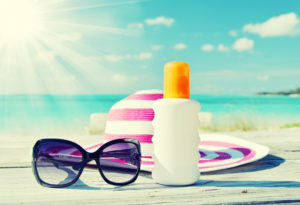
With summer here, it’s time to understand the benefits of sunscreen. The reason for sunscreen is that the sun emits two harmful types of ultraviolet (UV) rays: UVA and UBA, which both lead to increased risk of skin cancer. Exposure to UVA rays has also been known to cause wrinkles. Research from the Environmental Protection Agency has established that up to 90% of skin changes from aging is actually caused by your skin’s exposure to UVA rays throughout your lifetime. Thus, limiting exposure by using sunscreen will help prevent signs of aging.
Dermatologists recommend a sun protection factor (SPF) of 15 or higher. Anyone with fair skin or a history of skin cancer should opt for SPF 30 or higher. While choosing a product with a high SPF is a good start, it’s important to understand that SPF only protects against UVB rays. In order to find coverage against UVB and UVA, look for products that are called “broad-spectrum sunscreens,” as these products include additional protection from UVA. There is no rating system to assess how well a sunscreen will block UVA rays, so reading the list of ingredients is key. To project against UVA rays, choose a product with any of the following ingredients: ecamsule, avobenzone, oxybenzone, titanium dioxide, sulisobenzone, or zinc oxide.
Another important consideration is the impact the sunscreen’s ingredients have on the environment, especially if swimming in the ocean due to fragile coral reefs. Some beaches in Hawaii and Florida ban sunscreens that contain certain chemicals such as octocrylene, oxybenzone, and octinoxate. When looking for eco-friendly options consider buying a mineral-based sunscreen with “non-nanotized” zinc oxide or titanium dioxide. While mineral-based products are not as effective at blocking UV rays, they still can offer decent coverage. A good compromise for maximum protection and environmental awareness would be to select an oxybenzone-free chemical sunscreen. Oxybenzone is a chemical known for environmental damage.
Once you have selected a broad-spectrum sunscreen with an SPF of 15+, be sure to apply it 15 to 30 minutes before sun exposure. Typically, one ounce (roughly two tablespoons) will be enough to cover the body. It’s important to apply an even and consistent layer. Regardless of how long the sunscreen is supposed to last, it’s best to reapply every two hours (more if you are exercising or swimming). Be sure to wear sunscreen on cloudy days, as well as sunny ones, as clouds do not stop UV rays. Pay attention to expiration dates, as sunscreen loses effectiveness over time. While sunscreen is a good first defense, no sunscreen can fully protect 100% against UV rays. In addition to wearing sunscreen: opt for shade when possible, wear hats and sunglasses, and aim to void the sun’s most intense hours from 10 a.m. to 4 p.m.
More
 It’s easy to remember that smoking can put you at risk for cancer, but it can be easy to forget that the summer sun we love so much can be just as dangerous. According to the Skin Cancer Foundation, each year in the United States over 5.4 million cases of non-melanoma skin cancer are treated in more than 3.3 million people. Every year, there are more new cases of skin cancer than the combined incidences of breast, prostate, lung, and colon cancer, and over the past 30 years, more people have had skin cancer than all other cancers combined.
It’s easy to remember that smoking can put you at risk for cancer, but it can be easy to forget that the summer sun we love so much can be just as dangerous. According to the Skin Cancer Foundation, each year in the United States over 5.4 million cases of non-melanoma skin cancer are treated in more than 3.3 million people. Every year, there are more new cases of skin cancer than the combined incidences of breast, prostate, lung, and colon cancer, and over the past 30 years, more people have had skin cancer than all other cancers combined.
You don’t have to stay indoors all summer long to protect yourself from skin cancer, but you do need to understand the risks and make choices that will limit your direct sun exposure. Read on for our summer sun safety best practices, and tips for choosing the SPF that’s right for you.
Tips to Limit Your Sun Exposure
- Stay in the shade, especially between 10 a.m. and 4 p.m., and during late spring and early summer when UV rays are the strongest.
- Do not intentionally tan.
- Avoid sunburns. Getting sunburned just once every two years can triple your risk of developing melanoma skin cancer.
- Wear a broad-brimmed hat and sunglasses with UV-coating to protect your face and eyes.
- Wear long sleeves and pants of breathable fabric while out in the sun.
- Use extra caution around water, snow, and sand, as such surfaces reflect damaging rays, which can increase your chance of a sunburn.
- Protect yourself, even on cloudy or hazy days, as 80% of damaging UV rays can still reach you through the clouds.
- Wear sleeves or sunscreen even when driving. Harmful UVA rays can still reach you through window glass.
Sunscreen and SPF Facts
- Sunscreens are regulated as over-the-counter drugs by the U.S. Food and Drug Administration.
- SPF stands for sun protection factor. Sunscreens with a higher SPF generally offer more protection from the sun’s UV radiation.
- The SPF rating on a sunscreen product refers mainly to the level of UVB protection it offers. For example, SPF 15 blocks 93% of UVB radiation, while SPF 30 blocks nearly 97%. Higher sunscreens block slightly more UV rays, but no sunscreen can offer 100% protection.
- SPF clothing is 100% effective at blocking UV rays, making it more effective than regular cotton materials.
- The FDA has banned sunscreens from claiming to be waterproof or sweat proof, however there are products available that offer protection if you plan to be in the water. Water resistant products are generally effective for up to 40 minutes in water, while very water resistant products are generally effective for up to 80 minutes in the water.
SPF Recommendations
- When outdoors, always apply a broad spectrum (UVA/UVB) sunscreen of SPF 30 or higher. Such sunscreens protect you from both types of damaging UV rays.
- When choosing sunscreens, read the label. If a product has a skin cancer/skin aging alert in the Drug Facts section, it means it will only prevent sunburn and will NOT reduce the risk of skin cancer.
- Always choose a sunscreen that is water resistant, but especially if you anticipate extended outdoor activity.
- Apply one ounce of sunscreen (enough to fill a shot glass) to your entire body, and to dry skin, 15 to 30 minutes before going outside.
- Reapply sunscreen every two hours or immediately after swimming or excessive sweating.
- Don’t forget to protect your lips. Choose a lip balm that contains at least SPF 30.
- Rather than using a product that claims to offer SPF and insect repellent, use these products separately for best results.
- Check the date of your sunscreen. The FDA requires that sunscreens retain their strength for at least three years. If you have an old bottle at home, or one that has passed its expiration date, replace it.
- Sunscreens come in a variety of forms. Choose the one that best fits your needs:
- Creams – Best for the face and dry skin.
- Sprays – Often chosen by parents for their convenient application, just be sure to apply the proper amount.
- Gels – Best for hairy areas.
- Sticks – Best for application around the eyes.
If you have any questions or concerns regarding summer sun exposure, or your personal risk factors for skin cancer, talk to your doctor. Chouchani, Sayegh and Robinson MD are currently accepting new patients. Call for an appointment today.
More


